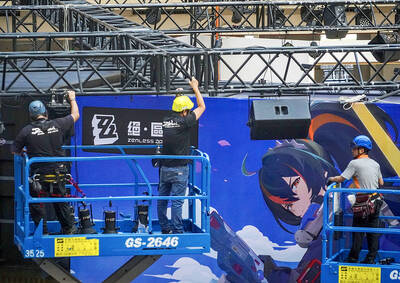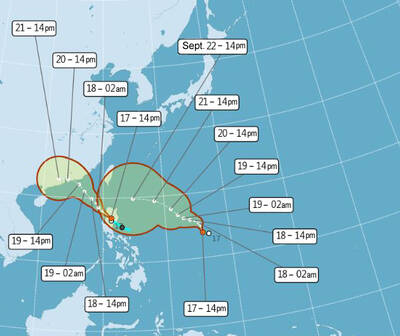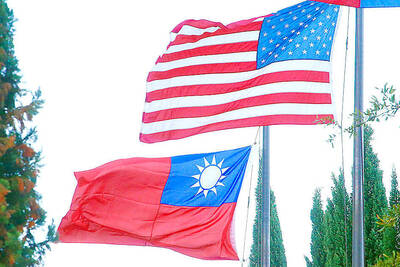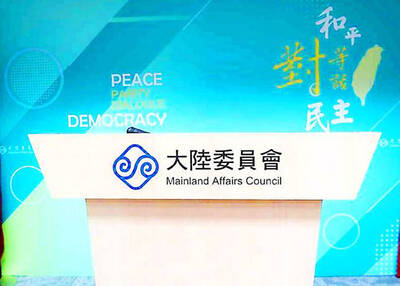While funding for Kaohsiung City's long-awaited mass rapid transit system will have another chance of receiving approval this month, the prospects don't seem to be getting any better for Kaohsiung Mayor Frank Hsieh (
Early signs already indicate that Hsieh's budget will be rejected.
The Kaohsiung City Council plans to begin discussing the bud-get for the mass rapid transit system at the committee level on Nov. 11, with the final vote scheduled for Nov. 29.

PHOTO: CHEN CHENG-CHANG TAIPEI TIMES
If this happens, the Executive Yuan will almost certainly cut its funding for the project, dramatically reducing the staff of the Kaohsiung City Government's Department of Rapid Transit Sys-tems.
The Executive Yuan is losing patience with the department, which currently employs 123 people who are waiting for construction to begin.
According to statistics, the Executive Yuan has agreed to fund 69 percent of the proposed NT$195.2 billion budget, so lack of central government support will effectively kill the project.
There are other reasons why this is probably Hsieh's last chance to build the mass transit system.
While real estate prices are relatively low at the moment, they are expected to rise soon, increasing the cost of the land needed for stations along the line.
Furthermore, Taoyuan, Tai-chung and Tainan are waiting on the central government for approval of their own mass rapid transit systems.
A source inside the Department of Rapid Transit Systems said: "If the Kaohsiung City Council cannot pass the budget this month, the chance may go to another city."
Sources close to Hsieh say that if construction does not begin within two years, he will probably see out his term of office and step down.
The city council's main objection to the budget is that it is too vague.
"The information provided by the city government is not clear enough. The budget is more like a rough draft than a financial plan,"said Hong Mao-jun (
This is why Hsieh's first budget was rejected in June and, according to Hong, there has been no improvement since.
In the face of opposition from the KMT councilor, Hsieh is going on the offensive, claiming that such criticism is politically motiva-ted.
If Hsieh, the first DPP mayor of Kaohsiung, succeeds in building the line where his KMT predecessors failed, his re-election is almost assured, and the KMT will find it difficult to regain a foothold in Taiwan's second largest city.
Hsieh says this is why local KMT councilors and the central government are against his plan.
However, Hsieh also has enemies within his own party.
Kuo Wen-cheng (
As the struggle becomes more intense, Hsieh has turned to the media to publicize his cause.
He has vocally criticized the city council and the central government in the press for using opposition to the project as a weapon against his opponents.
Hsieh has been vigorously canvassing city councilors for support. Rumors of votes being exchanged for favors have risen in turn.
It has been said that Hsieh is giving administrative positions in City Hall to relatives of city councilors in return for their support.
It is very difficult to tell what the result of the Nov. 29 vote will be. Everything depends upon what happens during the next few weeks.
Most Kaohsiung residents, who have to fight their way through the rush hour traffic twice a day, shake their heads at the situation.
"Taipei has an MRT. Why not Kaohsiung?" one resident asked.
Although many are behind Hsieh and the project, after 10 years of waiting through five different administrations, the public is resigned to the fact that he too may fail.

Taiwan is projected to lose a working-age population of about 6.67 million people in two waves of retirement in the coming years, as the nation confronts accelerating demographic decline and a shortage of younger workers to take their place, the Ministry of the Interior said. Taiwan experienced its largest baby boom between 1958 and 1966, when the population grew by 3.78 million, followed by a second surge of 2.89 million between 1976 and 1982, ministry data showed. In 2023, the first of those baby boom generations — those born in the late 1950s and early 1960s — began to enter retirement, triggering

One of two tropical depressions that formed off Taiwan yesterday morning could turn into a moderate typhoon by the weekend, the Central Weather Administration (CWA) said yesterday. Tropical Depression No. 21 formed at 8am about 1,850km off the southeast coast, CWA forecaster Lee Meng-hsuan (李孟軒) said. The weather system is expected to move northwest as it builds momentum, possibly intensifying this weekend into a typhoon, which would be called Mitag, Lee said. The radius of the storm is expected to reach almost 200km, she said. It is forecast to approach the southeast of Taiwan on Monday next week and pass through the Bashi Channel

NO CHANGE: The TRA makes clear that the US does not consider the status of Taiwan to have been determined by WWII-era documents, a former AIT deputy director said The American Institute in Taiwan’s (AIT) comments that World War-II era documents do not determine Taiwan’s political status accurately conveyed the US’ stance, the US Department of State said. An AIT spokesperson on Saturday said that a Chinese official mischaracterized World War II-era documents as stating that Taiwan was ceded to the China. The remarks from the US’ de facto embassy in Taiwan drew criticism from the Ma Ying-jeou Foundation, whose director said the comments put Taiwan in danger. The Chinese-language United Daily News yesterday reported that a US State Department spokesperson confirmed the AIT’s position. They added that the US would continue to

The number of Chinese spouses applying for dependent residency as well as long-term residency in Taiwan has decreased, the Mainland Affairs Council said yesterday, adding that the reduction of Chinese spouses staying or living in Taiwan is only one facet reflecting the general decrease in the number of people willing to get married in Taiwan. The number of Chinese spouses applying for dependent residency last year was 7,123, down by 2,931, or 29.15 percent, from the previous year. The same census showed that the number of Chinese spouses applying for long-term residency and receiving approval last year stood at 2,973, down 1,520,